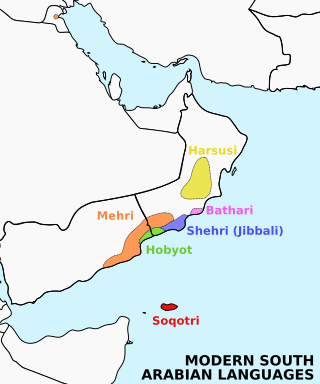Top Qs
Timeline
Chat
Perspective
Modern South Arabian languages
Group of South Semitic languages of Arabia and Socotra From Wikipedia, the free encyclopedia
Remove ads
The Modern South Arabian languages,[1][2] also known as Eastern South Semitic languages, are a group of endangered languages spoken by small populations inhabiting the Arabian Peninsula, in Yemen and Oman, and Socotra Island. Together with the Ethiosemitic and Sayhadic languages, the Western branch, they form the South Semitic sub-branch of the Afroasiatic language family's Semitic branch.
Mehri and Hobyot are spoken in both Yemen and Oman. Soqotri is only spoken in the Yemeni archipelago of Socotra, and the Harsusi, Bathari, and Shehri languages are only spoken in Oman.[3]
Remove ads
Classification
In his glottochronology-based classification, Alexander Militarev presents the Modern South Arabian languages as a South Semitic branch opposed to a North Semitic branch that includes all the other Semitic languages.[4][5] They are no longer considered to be descendants of the Old South Arabian language, as was once thought,[citation needed] but instead "nephews".
Languages
- Mehri: It is the largest Modern South Arabian language.[3] As of 2024, there are about 250,300 speakers of this language, 190,000 of whom live in Yemen,[6] and around 40,000 speakers live as guest workers in Kuwait, The UAE, and Saudi Arabia.[citation needed] The language is spoken by the Mehri people.[6]
- Soqotri: another relatively numerous examples, with speakers exclusively on the Yemeni island of Socotra. As of 2012, there were around 60,000 speakers.[7]
- Shehri: also called Jibbali, meaning "of the Mountains", is spoken in the Dhofar Governorate of Oman, with an estimated 10–30,000 speakers; it is best known as the language of the rebels during the Dhofar Rebellion along the border with Yemen in the 1960s and 1970s.[citation needed]
- Harsusi: under 1,000 speakers in the Jiddat al-Harasis of Oman.[7]
- Bathari: Under 100 speakers in Dhofar.[7] Located on the southeast coast facing the Khuriya Muriya Islands. Very similar to Mehri, and some tribespeople speak Mehri instead of Bathari.[citation needed]
- Hobyót: under 1,000 speakers, along the Omani-Yemeni borders.[7]
Remove ads
Phonology
Summarize
Perspective
Modern South Arabian languages are known for their apparent archaic Semitic features, especially in their system of phonology. For example, they preserve the lateral fricatives *ś [ɬ] and *ṣ́/ḏ̣ [ɬʼ] of Proto-Semitic.
Modern South Arabian languages maintain the distinction which is lost in all spoken Arabic dialects but preserved in Classical Arabic between the two coronal emphatics represented by the Arabic letters ض /dˤ/ ḍād and ظ /ðˤ/ ẓāʾ. In contrast to Arabic, where this distinction is represented by a stop-continuant contrast at the alveolar or pre-dental place of articulation, Modern South Arabian languages preserve a lateral-central distinction (ض /ɬʼ/ vs. ظ /θʼ ~ ðʼ/). The lateral ض /ɬʼ/ is the emphatic counterpart to the lateral /ɬ/, which has become iconic of the Modern South Arabian languages, owing to its relative rarity in the world’s languages.[8]
Semiticists are nearly unanimous in the opinion that Proto-Semitic contained three plain sibilants, referred to by the shorthand *s1, *s2 , and *s3, and confusing also as š, ś, and s. The realizations of these phonemes in earlier times is debated, these three plain sibilants have been preserved in Mehri and Shehri, on the other hand in Arabic *s and *š merged into Arabic /s/ ⟨س⟩ and *ś became Arabic /ʃ/ ⟨ش⟩.
Origins
Militarev identified a Cushitic substratum in Modern South Arabian, which he proposes is evidence that Cushitic speakers originally inhabited the Arabian Peninsula alongside Semitic speakers (Militarev 1984, 18–19; cf. also Belova 2003). According to Václav Blažek, this suggests that Semitic peoples assimilated their original Cushitic neighbours to the south who did not later emigrate to the Horn of Africa. He argues that the Levant would thus have been the Proto-Afro-Asiatic Urheimat, from where the various branches of the Afro-Asiatic family subsequently dispersed. To further support this, Blažek cites analysis of rock art in Central Arabia by Anati (1968, 180–84), which notes a connection between the shield-carrying "oval-headed" people depicted on the cave paintings and the Arabian Cushites from the Old Testament, who were similarly described as carrying specific shields.[9]
Remove ads
Reconstruction
Proto-Modern South Arabian reconstructions by Roger Blench (2019):[10]
Remove ads
References
Bibliography
External links
Wikiwand - on
Seamless Wikipedia browsing. On steroids.
Remove ads

